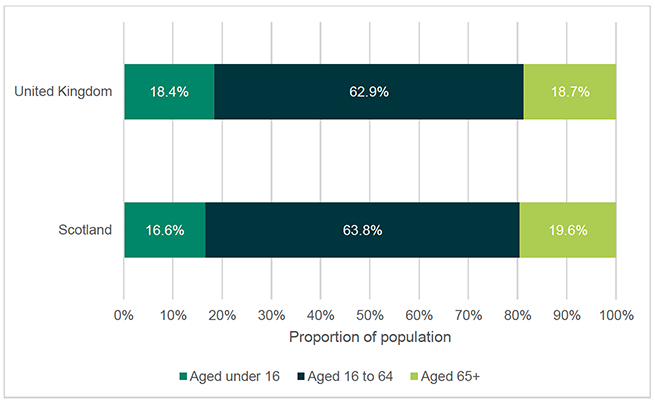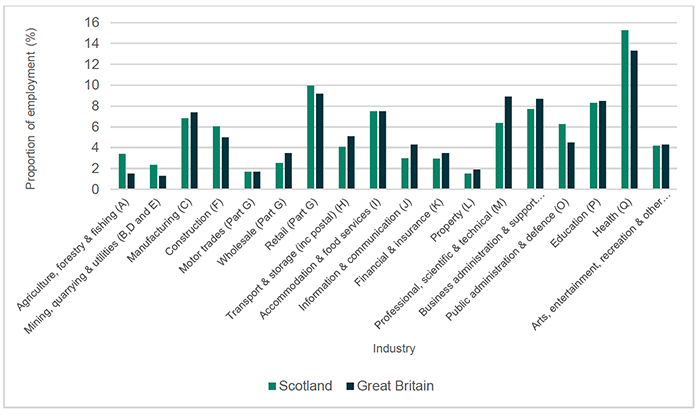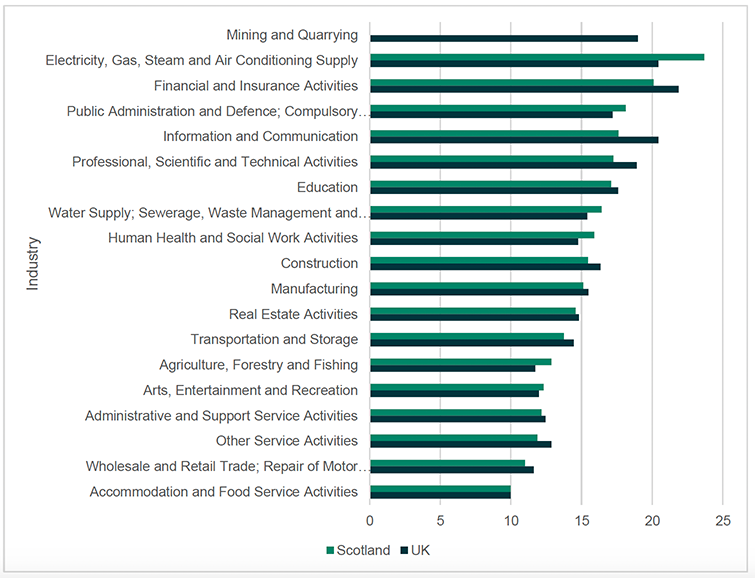Fair Work action plan 2022 and Anti-Racist Employment Strategy 2022: business and regulatory impact assessment
Business and Regulatory Impact Assessment (BRIA) of the Fair Work Action Plan 2022 and Anti-Racist Employment Strategy 2022.
Appendix E: Evidence and key issues
Population
The latest (mid-2021) estimate of the Scottish population is 5,479,900.[76] The population has grown 0.25% since mid-2020, which is 0.17 percentage points lower than the average annual growth from mid-2014 to mid-2019[77].
Approximately 63.8% of residents in Scotland were of working age (16 to 64 years old), whilst 19.6% were aged 65+, as shown in Figure E-1. Meanwhile, the working age population of the UK overall represented a slightly lower proportion of the total population (62.9%)[78].

Source: Office for National Statistics (2021).
Jobs and Businesses
BRES data identifies the number of jobs by industry sector across Scotland. In 2021, the largest employment sectors in Scotland were: the Health sector (15.3% of jobs); Retail sector (10.0% of jobs); and, Education (8.3% of jobs). Two of the largest sectors across Great Britain as a whole in 2021 were also Health (13.3%) and Retail (9.2%). However, Great Britain's third largest sector is the Professional, Scientific, and Technical sector (8.9% of jobs), which comprises a lower proportion of jobs, 6.4%, in Scotland. The proportion of jobs in across all industry sectors in Scotland and Great Britain is shown in.

Source: BRES (2021)
In 2022, there were 173,655 businesses registered in Scotland[79]. Of these, the majority (87.8%) were classed as micro (employing 0 to 9 people), 10.2% were small (10 to 49 employees), 1.6% were medium (50 to 249 employees) and 0.4% were large (250+ employees).
The sector with the largest number of registered enterprises was the professional, scientific, and technical industry, representing 15.1% of businesses. Following this was the construction industry (12.5% businesses), and agriculture, forestry, and fishing (9.9% businesses).
The National Performance Framework also details how Scotland performs across national indicators on 'high growth business' and 'innovative business' growth. In 2022, 0.9% of all registered businesses in Scotland were considered high growth, down from the 2021 rate of 1.2%. At 6.5%, the high growth business rate was the highest in the 'Mining and Quarrying' industry sector and foreign-owned businesses had the highest high growth business rate (6.7%)[80].
Labour Market
The employment rate in Scotland has fluctuated since 2004, experiencing a steep decline in employment between 2008-2012 in line with the recession and between 2019-2021 in line with Covid-19. The employment rate has since increased to 73.2% in Jan-Dec 2021. While the unemployment rate figures peaked at 8.2% in 2011 and have fluctuated since 2017 to 3.9% in 2021.[81]
Productivity
Economic productivity can be measured as Gross Value Added (GVA) which is a measure of the goods and services produced in an area. In Scotland in 2020, GVA per worker was £26,572. This figure was lower than the average GVA per worker across the UK (£29,063)[82].
Gross Domestic Product (GDP) is a measure of the size and health of the economy over one quarter of a year. In 2022 Q3, Scotland's onshore GDP is estimated to have fallen by 0.1% compared to the previous quarter. However, compared to the same quarter in 2021, income from employment is estimated to have increased by 5.9%[83].
Hours and Earnings
The Annual Survey of Hours and Earnings (ASHE)[84] provides information about the structure and distribution of earnings across industries in Scotland and the UK as a whole.
The median gross hourly pay in Scotland in 2022 was £15.03 which is a similar figure to that in the UK (£14.77). As shown in figure E-3, when broken down by industry, there were differences between the two geographies. In Scotland, the industry with the greatest median gross hourly pay was electricity, gas, steam, and air conditioning supply, at £23.68[85]. This was followed by financial and insurance activities at £20.10, and public administration and defence; compulsory social security at £18.13. The industry with the lowest median gross hourly pay was accommodation and food service activities (I) at £10.00. Estimates in Scotland for B: Mining and Quarrying are considered unreliable for practical purposes.
In the UK as a whole, the industrial group with the highest median gross hourly pay was financial and insurance activities at £21.88, followed by electricity, gas, steam, and air conditioning supply (D) at £20.46[86], and information and communication at £20.44, and. Similar to Scotland, the industry paying the lowest mean gross hourly pay in the UK was accommodation and food service activities (I) at £10.00.

Source: Annual Survey of Hours and Earnings (2022)
Source: Annual Survey of Hours and Earnings (2022)
In 2022, 91.0% of all employees (18+) were paid the real Living Wage in 2022.[88] Sectoral analysis reveals that over 80% of private sector employees were paid at least the real Living Wage and over 90% of public and third sector employees. While a higher percentage of men have been paid the real Living Wage compared to women between 2012 and 2022.
Research from the Living Wage Foundation[89] shows that:
- Of the 840 employers surveyed across the UK (201 in Scotland), 93% of Living Wage Businesses reported feeling they have benefited since accrediting. 86% of their respondents said it has improved the reputation of their organisation and 75% said it has increased motivation and retention rates of employees. Businesses also reported a 25% drop in absenteeism.
- Paying the real Living Wage can help businesses attract new workers and skills: 93% of students want to work for employers who pay at least the real Living Wage.
- Currently, two-thirds of workers earning below the real Living Wage in the UK are women.
Public Sector Grants and Funding
A wide range of public sector are currently available to businesses in Scotland, and Fair Work First has been applied to some £4 billion worth of public sector funding since 2019. This figure does however not include crisis support grants and given the range of funding across the public sector the breadth of the information makes it difficult to compile a comprehensive dataset for analysis.
Scottish Enterprise is Scotland's national economic development agency and a non-departmental public body of the Scottish Government. It is one of the key organisations that allocates government grant funding, including, but not limited to, the following:
- Scottish Venture Fund: an equity gap fund investing alongside private sector investors, offering equity funding from £10,000 up to £2 million;
- Scottish Co-Investment Fund: an equity fund matching accredited investment partners up to a maximum of 50% of the total funding package on a commercial basis. Provide from £10,000 up to £2 million;
- Workplace Innovation Fund: a fund to contribute up to £5,000 towards activities that will allow businesses to introduce new and innovative workplace practices. It will support projects centred on at least two out of the three following: people, place, and practice; and
- SMART Scotland: a research and development (R&D) grant for SMEs that aims to support high-risk, highly ambitious projects to conduct feasibility studies. Projects must last between six and 18 months, and the maximum grant is £100,000.
Since 2019 Scottish Enterprise has attached Fair Work First (FWF) criteria to all large job creation grants of £100,000 plus (condition that new jobs must pay the real Living Wage); and since January 2021 has extended the principles to all grants, with a new business process going live from September 2021 across all relevant business areas.
87% of Scotland's business base is represented in the SE region, i.e. c.155k registered businesses employing some 1.6m people.
In the 2 years pre-Covid, SE awarded an average of 2,761 grants per annum, totalling on average £172m per annum; in 2021 6,895 grants were awarded - 90% being Covid-related.
Other grants are also available to businesses in Scotland[90]:
- Business Gateway: Offer business grants such as the Scottish Loan Scheme (SLS) which can provide loan funding of £250,000 - £2m to growth focused Scottish companies.
- Highlands and Islands Enterprise: works with businesses, social enterprises and communities across Shetland to Argyll, the Outer Hebrides, and Moray.
- South of Scotland Enterprise: available for businesses and enterprising communities throughout Dumfries and Galloway and the Scottish Borders.
- Scottish Growth Scheme: a package of financial support of up to £500m for Scottish businesses. It offers microfinance loans of up to £25,000, debt or loan finance of up to £100,000, and equity finance of up to £2m;
- Open Fund: Supporting Creative Development: the Open Fund is for individuals and organisations within the creative industries. Funding is available for between £500 and £100,000 and is open all year round, with no deadlines and can support activity for up to 12 months;
- Scottish Edge: a competition aimed at identifying and supporting Scotland's up-and-coming, innovative, high-growth potential entrepreneurial talent. Winners can receive up to £100,000 in funding plus a business support package to help them make the most of any grant money;
- Forestry Grant Scheme: this scheme is focused on providing financial support for businesses involved in the creation of either new woodland spaces or the sustainable management of existing woodlands. It is managed by the Scottish Rural Payments and Services agency and Scottish Forestry;
- Small Innovation Grants Scheme: open to SMEs in the Highlands and Islands. The grants are administered by the Highlands and Islands Enterprise agency, which is based in Inverness. The agency can offer grants of up to £15,000;
- Culture and Business Fund Scotland: Scottish social enterprises can apply for this funding which is managed by Arts & Business Scotland, an independent charity. The fund offers pound for pound match funding for eligible projects of between £1,000 and £40,000; and
- Workforce Upskilling Grant: this grant is for businesses based in Fife looking to improve the productivity and profitability of their business through staff training.
- Workplace Equality Fund: supports private and public sector employers to improve their policies and practices to address inequalities in the workplace. Up to £800,000 was made available in Year 1/2022-23.
Trade Union Membership[91]
In 2021, the proportion of employees who were trade union members in Scotland was 28.4%, higher than in the UK as a whole at 23.1%. In Scotland, this represented a fall and membership density was down 0.7% from 2020, compared to the UK where it was down 0.8% from 2020. The decrease in Scotland has occurred gradually and since 1995, the proportion of employees who are trade union members has fallen by 10.6%.
Data for every industry is not available, however based on available data the industry in Scotland with the highest proportion of employees who are trade union members in 2021 was electricity, gas, steam, and air conditioning supply (60.9% of workers were members). This was followed by education (54.1%) and human health and social work (49.7%). In contrast, the industry with the lowest proportion of trade union members was manufacturing in which only 12.2% are members[92]. These trends are similar to those across the UK as a whole where the education industry contained the highest proportion of trade union members (49.4%) followed by human health and social work (39.2%) and public administration and defence (38.6%).
Benefits of Fair Work Practice
A number of research papers have sought to demonstrate how Fair Work practices can drive productivity, release untapped potential and inspire innovation - all of which add value to jobs and to business and in turn create stronger, more sustainable and inclusive growth:
- A report by Carnegie UK and the RSA[93] sets out a range of evidence supporting the finding that "higher quality work, like higher pay, can serve as a spur to greater work satisfaction and motivation, thus leading to higher levels of workplace productivity. More productive, higher-performing firms are more likely to invest in enhanced worker security, opportunity, training, and engagement". The report presents evidence there is 8% higher productivity in those workers most satisfied with pay compared to those least satisfied; and, firms with engaged employees experience around 40% less turnover of staff, representing significant savings for firms since turnover of staff is known to be costly – replacing a skilled worker costs typically 150% of their salary.
- In addition, the report above finds that organisations in the highest scoring quartile have been shown to be 22% more profitable on average than those in the bottom quartile and have 21% higher productivity.
- The Taylor Review of Modern Working Practices[94] highlights that good work for all should be a national priority across the UK. It outlines that most businesses understand that providing 'good work' is not only a good thing to do in and of itself, but can also deliver business benefits. Analysis of European data from 1995–2000 suggests that countries with higher job quality have higher levels of labour productivity and vice versa"[95].
- A University of Warwick study also examined the relationship between Fair Work and productivity. It found evidence of positive impacts on productivity across several dimensions of Fair Work including pay and benefits; health, safety and psychosocial wellbeing; job design and the nature of work; and work-life balance.[96]
- The Joseph Rowntree Foundation has also carried out research demonstrating poverty can impact individual employee performance. For example, financial worry and stress can reduce the effectiveness, quality, and efficiency of work undertaken by employees. Fair Work measures that address the issues of financial worry and stress could therefore benefit business performance, as well as individual wellbeing. In addition, poverty is estimated to cost the UK public purse approximately £78 billion annually and indirectly all businesses, like other taxpayers, pay part of this cost. Implementing practices such as the real Living Wage could help to reduce in work poverty, and in turn this indirect cost[97].
- Research carried out by the OECD has also found a strong correlation of a negative relationship between job stress and at-work productivity, and a positive relationship between job rewards and productivity.[98]
- A 2019 McKinsey and Company report demonstrated employers committing to diversity and inclusion have been demonstrated to benefit in business terms.[99] The research shows that companies in the top-quartile for ethnic/cultural diversity on executive teams were 33% more likely to have industry-leading profitability.
- Chartered Institute of Personnel and Development (CIPD) research shows taking an anti-racist and proactive approach to addressing racial inequality in the workplace as well as other inequalities can also help to attract employees and improve corporate reputation. Research shows that people want to work for employers with good employment practices[100].
- Research carried out by Mencap[101] shows that employing people with learning disabilities can have numerous benefits such as higher retention, better awareness of disability issues amongst staff, and increased reputation amongst the general public.
- A report by Close the Gap to inform the 2017 Scottish Parliament debate on the Economy, Jobs and Fair Work Committee inquiry into the gender pay gap calculated that closing the gender gap in employment could be worth more than £17bn to the Scottish economy[102].
Contact
There is a problem
Thanks for your feedback